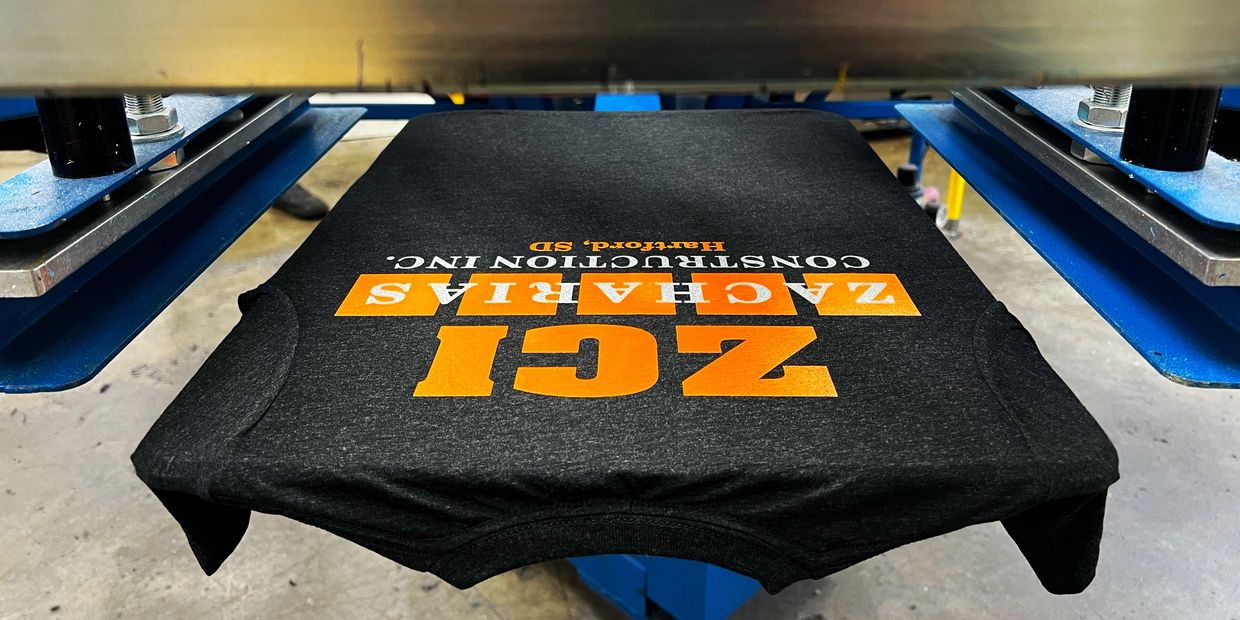Creative T-Shirt Printing Ideas for Small Brands
Wiki Article
Display Printing Uncovered: Everything You Required to Know About Tee Shirt and Garment Printing Strategies
If you have actually ever before asked yourself just how those vivid designs wind up on your favorite t-shirts, you're in the right place. Screen printing is an interesting technique that integrates art with method, using countless opportunities for creative thinking. Understanding the basics, from devices to ink selections, can substantially impact your results. All set to discover the crucial aspects that make display printing an art type? Allow's discover the information that can elevate your jobs.
The Essentials of Screen Printing: Just How It Works
When you dive into screen printing, you'll uncover it's both an art and a science. At its core, display printing includes developing a pattern, or screen, that permits ink to travel through only in specific locations (screen printing kit). You begin by selecting your design and preparing your display with a light-sensitive solution. Once you expose this emulsion to light, it hardens, leaving your design as an unfavorable area.Following, you'll mix your inks and prepare your printing surface. Placement the screen over the fabric, after that use a squeegee to press ink via the screen onto the garment. This process calls for accuracy, as you desire clear, vivid prints. After printing, you'll heal the ink with warmth, guaranteeing it abides by the material and lasts with cleans. Each action is important, and mastering them will certainly elevate your screen printing abilities, transforming straightforward garments into one-of-a-kind, expressive pieces.
Sorts Of Screen Printing Methods
Once you realize the fundamentals of screen printing, it's time to check out the numerous techniques that can elevate your designs. One preferred technique is traditional display printing, where ink is pressed with a stenciled screen. This technique is terrific for strong, vivid colors. After that there's water-based ink printing, which supplies a softer feeling and is green, yet it calls for a various technique to treating.If you're aiming for fine information, take into consideration discharge printing. This strategy eliminates dye from the fabric, leaving a soft, classic appearance. An additional choice is plastisol printing, understood for its toughness and brilliant shades, making it a preferred for lots of brands. Experiment with halftone printing to produce gradient effects and elaborate designs. Each technique has its one-of-a-kind charm, so don't hesitate to attempt them out to locate what fits your style best!
Important Tools for Screen Printing
To attain magnificent outcomes in screen printing, having the right equipment is essential. You'll require a durable display printing frame, which holds the mesh that transfers your layout onto the garment. Next off, invest in top notch squeegees; these are important for using ink equally throughout the screen.Choosing the Right Inks and Materials
When picking inks and materials for screen printing, you require to take into consideration the kind of ink that works best for your task. Think concerning textile compatibility to ensure your designs look fantastic and last lengthy. Check out environment-friendly ink alternatives to make your printing procedure a lot more lasting.Sorts Of Display Inks
Selecting the ideal display ink is crucial for attaining vibrant, durable prints that meet your project's needs. There are a number of types of display inks to take a look at. Plastisol ink is prominent for its flexibility and ease of use, giving superb color opacity on dark fabrics. Water-based ink, on the various other hand, provides a softer feeling and is green, making it excellent for those aiming to lessen their environmental impact. Release inks remove dye from the fabric, resulting in a soft, classic look but need particular handling. Specialized inks, such as glow-in-the-dark or metal, can add special effects to your styles. Review your task requirements and pick the ink that lines up best with your wanted outcome.
Fabric Compatibility Factors To Consider
Comprehending material compatibility is crucial for attaining top notch screen prints, especially because different products respond distinctively to various inks. When choosing inks, consider the textile kind-- cotton, polyester, or blends. For cotton, water-based inks function well, offering softness and breathability. Polyester, on the other hand, usually requires plastisol inks for much better attachment and lively colors. You might need to use a mix of both kinds if you're printing on blends. Always examine your inks on example material to guarantee they stick effectively and keep shade stability. In addition, maintain in mind that textile weight and appearance can impact the final result, so selecting the right ink and material combo is crucial for your job's success.Eco-Friendly Ink Options
Green inks are coming to be a preferred choice for display printers who want to minimize their ecological impact while preserving silk screen printing high quality. When choosing inks, take into consideration water-based inks, which are much less hazardous and simpler to clean up compared to standard solvents.In addition, seek inks made from renewable energies, such as soy or vegetable-based alternatives. By choosing the right inks and materials, you'll not just develop magnificent layouts however likewise contribute to a more lasting printing procedure. Make the button, and your prints will certainly reflect your commitment to the setting!
Preparing Your Design for Screen Printing

Submit Format Requirements
To guarantee your layout looks sharp and lively on textile, you'll need to pay close interest to file layout demands for screen printing. Make certain your layout has a clear history to avoid undesirable white edges on your prints. Maintain shade settings in mind; CMYK is conventional for display printing, so transform your RGB makes accordingly.Color Splitting Up Methods
Shade splitting up is a crucial action in preparing your style for screen printing, and understanding it can substantially boost your print high quality. You'll need to break your design right into individual shades, as each shade calls for a separate screen throughout printing. Beginning by determining all the shades in your design and develop layers for each one. You can use software program like Adobe Photoshop or Illustrator to isolate and separate colors successfully. Be specific to conserve each layer as a separate file, typically in a layout like TIFF or PSD. This precision not just guarantees accurate shade representation yet additionally streamlines the printing procedure. By paying focus to color separation, you'll attain vibrant and expert lead to your screen-printed garments.Resolution and Size
Attaining the most effective cause screen printing starts with ensuring your layout has the ideal resolution and size. Ideally, your artwork should be at the very least 300 DPI (dots per inch) for sharp, clear prints. If you use lower resolution, your last item may look amateur and pixelated.When it comes to size, think about the measurements of your print area. Layout your artwork to match the final print size, ideally developing it in the actual measurements you'll be printing. By doing this, you'll avoid any unexpected scaling problems.
Always check your design in both vector and raster formats. Vector graphics can be scaled without losing top quality, making them suitable for display printing. Preparing properly will guarantee your style looks amazing on every garment!
Step-by-Step Screen Printing Process
Display printing is a dynamic process that enables you to develop lively layouts on numerous surface areas. To obtain begun, you'll require a display, solution, and your picked ink.After washing out the unexposed solution, your display is ready. Set it up on your printing surface and align your garment beneath it. Put ink onto the display and utilize a squeegee to push the ink with the stencil onto the fabric. Raise the display thoroughly and allow the print completely dry. Finally, heal the ink using warmth to guarantee resilience. That's it! You've effectively screen printed your design.
Tips for Effective Display Printing Projects
While you're diving right into your display printing projects, keep in mind that preparation is vital to success. Begin by collecting all your materials-- inks, squeegees, displays, and garments. A clean office aids stop undesirable mistakes, so clean prior to you start.Following, validate your artwork is high-resolution and correctly sized for your garment. Examine your display for proper direct exposure and tidy it thoroughly to stay clear of spots. When blending your inks, adhere to the producer's standards to attain the appropriate uniformity.
During printing, use even stress with your squeegee for constant outcomes. Don't hurry; take your time to confirm each print fulfills your requirements. After printing, allow your garments dry entirely prior to dealing with or packaging them.
Lastly, always maintain a sample of your benefit future reference. In this manner, you can evaluate your progression and improve your methods with time. Pleased printing!

Often Asked Questions
How Long Does It Require To Establish up a Display Printing Task?
Setting up a display printing work normally takes about half an hour to an hour. You'll prepare the screens, mix inks, and readjust journalism. The time differs based upon complexity and experience, so stay organized!Can I Publish on Various Material Types Making Use Of the Very Same Method?
Yes, you can print on various material types making use of the exact same method, but you'll require to readjust your inks and setups. Some materials take in ink in a different way, so trying out guarantees the most effective outcomes for every material.What Prevail Errors to Avoid in Screen Printing?
When screen printing, stay clear of typical mistakes like utilizing the wrong ink, neglecting appropriate direct exposure times, or skipping pre-press checks. Constantly evaluate your arrangement and preserve tidy screens to assure high quality outcomes each time.Exactly How Can I Properly Tidy and Maintain My Display Printing Tools?
To effectively clean and keep your screen printing devices, you should on a regular basis wash displays with appropriate solvents, examine squeegees for wear, and assure all tools are saved dust-free and completely dry. Consistency stops costly repair services and enhances efficiency.Is Screen Printing Eco-friendly Contrasted to Other Approaches?
Display printing can be much more eco-friendly than other approaches, specifically if you make use of water-based inks and eco-conscious products. By choosing lasting materials and practices, you lower waste and lessen your influence on the world.Display Printing Uncovered: Whatever You Required to Know Regarding Tee and Garment Printing Techniques
At its core, display printing includes creating a pattern, or display, that allows ink to pass via only in details areas. Placement the display over the textile, after that use a squeegee to push ink with the display onto the garment. One prominent approach is typical display printing, where ink is pressed via a stenciled display.When selecting inks and products for screen printing, you need to take right into account the type of ink that functions finest for your job.
Report this wiki page